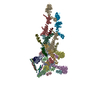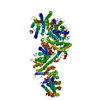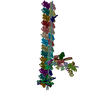+ Open data
Open data
- Basic information
Basic information
| Entry | Database: PDB / ID: 6lk8 | |||||||||
|---|---|---|---|---|---|---|---|---|---|---|
| Title | Structure of Xenopus laevis Cytoplasmic Ring subunit. | |||||||||
 Components Components |
| |||||||||
 Keywords Keywords |  STRUCTURAL PROTEIN / building block of vertebrate NPC. STRUCTURAL PROTEIN / building block of vertebrate NPC. | |||||||||
| Function / homology |  Function and homology information Function and homology informationmacromolecule localization / nitrogen compound transport / GATOR2 complex / nephron development / organic substance transport / macromolecule metabolic process / nuclear pore organization / nuclear pore outer ring / attachment of mitotic spindle microtubules to kinetochore / structural constituent of nuclear pore ...macromolecule localization / nitrogen compound transport / GATOR2 complex / nephron development / organic substance transport / macromolecule metabolic process / nuclear pore organization / nuclear pore outer ring / attachment of mitotic spindle microtubules to kinetochore / structural constituent of nuclear pore / nucleocytoplasmic transport / mitotic metaphase chromosome alignment / cellular response to nutrient levels /  intracellular transport / mRNA transport / intracellular transport / mRNA transport /  nuclear pore / positive regulation of TORC1 signaling / nuclear pore / positive regulation of TORC1 signaling /  kinetochore / kinetochore /  protein transport / protein transport /  nuclear membrane / lysosomal membrane / nuclear membrane / lysosomal membrane /  cell division / structural molecule activity / cell division / structural molecule activity /  metal ion binding / metal ion binding /  nucleus / nucleus /  cytosol cytosolSimilarity search - Function | |||||||||
| Biological species |  Xenopus laevis (African clawed frog) Xenopus laevis (African clawed frog) | |||||||||
| Method |  ELECTRON MICROSCOPY / ELECTRON MICROSCOPY /  single particle reconstruction / single particle reconstruction /  cryo EM / Resolution: 5.5 Å cryo EM / Resolution: 5.5 Å | |||||||||
 Authors Authors | Shi, Y. / Huang, G. / Yan, C. / Zhang, Y. | |||||||||
| Funding support |  China, 2items China, 2items
| |||||||||
 Citation Citation |  Journal: Cell Res / Year: 2020 Journal: Cell Res / Year: 2020Title: Structure of the cytoplasmic ring of the Xenopus laevis nuclear pore complex by cryo-electron microscopy single particle analysis. Authors: Gaoxingyu Huang / Yanqing Zhang / Xuechen Zhu / Chao Zeng / Qifan Wang / Qiang Zhou / Qinghua Tao / Minhao Liu / Jianlin Lei / Chuangye Yan / Yigong Shi /  Abstract: The nuclear pore complex (NPC) exhibits structural plasticity and has only been characterized at local resolutions of up to 15 Å for the cytoplasmic ring (CR). Here we present a single-particle ...The nuclear pore complex (NPC) exhibits structural plasticity and has only been characterized at local resolutions of up to 15 Å for the cytoplasmic ring (CR). Here we present a single-particle cryo-electron microscopy (cryo-EM) structure of the CR from Xenopus laevis NPC at average resolutions of 5.5-7.9 Å, with local resolutions reaching 4.5 Å. Improved resolutions allow identification and placement of secondary structural elements in the majority of the CR components. The two Y complexes in each CR subunit interact with each other and associate with those from flanking subunits, forming a circular scaffold. Within each CR subunit, the Nup358-containing region wraps around the stems of both Y complexes, likely stabilizing the scaffold. Nup205 connects the short arms of the two Y complexes and associates with the stem of a neighboring Y complex. The Nup214-containing region uses an extended coiled-coil to link Nup85 of the two Y complexes and protrudes into the axial pore of the NPC. These previously uncharacterized structural features reveal insights into NPC assembly. | |||||||||
| History |
|
- Structure visualization
Structure visualization
| Movie |
 Movie viewer Movie viewer |
|---|---|
| Structure viewer | Molecule:  Molmil Molmil Jmol/JSmol Jmol/JSmol |
- Downloads & links
Downloads & links
- Download
Download
| PDBx/mmCIF format |  6lk8.cif.gz 6lk8.cif.gz | 2.1 MB | Display |  PDBx/mmCIF format PDBx/mmCIF format |
|---|---|---|---|---|
| PDB format |  pdb6lk8.ent.gz pdb6lk8.ent.gz | 1.4 MB | Display |  PDB format PDB format |
| PDBx/mmJSON format |  6lk8.json.gz 6lk8.json.gz | Tree view |  PDBx/mmJSON format PDBx/mmJSON format | |
| Others |  Other downloads Other downloads |
-Validation report
| Arichive directory |  https://data.pdbj.org/pub/pdb/validation_reports/lk/6lk8 https://data.pdbj.org/pub/pdb/validation_reports/lk/6lk8 ftp://data.pdbj.org/pub/pdb/validation_reports/lk/6lk8 ftp://data.pdbj.org/pub/pdb/validation_reports/lk/6lk8 | HTTPS FTP |
|---|
-Related structure data
| Related structure data |  0909MC  0910C  0911C  0982C M: map data used to model this data C: citing same article ( |
|---|---|
| Similar structure data |
- Links
Links
- Assembly
Assembly
| Deposited unit | 
|
|---|---|
| 1 |
|
- Components
Components
-Protein , 11 types, 23 molecules AaCcDdEeFfHhIiJjSTUVKQR
| #1: Protein | Mass: 227854.141 Da / Num. of mol.: 2 / Source method: isolated from a natural source / Source: (natural)  Xenopus laevis (African clawed frog) / References: UniProt: Q642R6 Xenopus laevis (African clawed frog) / References: UniProt: Q642R6#3: Protein | Mass: 41744.512 Da / Num. of mol.: 2 / Source method: isolated from a natural source / Source: (natural)  Xenopus laevis (African clawed frog) / References: UniProt: Q05AW3 Xenopus laevis (African clawed frog) / References: UniProt: Q05AW3#4: Protein | Mass: 36037.664 Da / Num. of mol.: 2 / Source method: isolated from a natural source / Source: (natural)  Xenopus laevis (African clawed frog) / References: UniProt: Q4FZW5 Xenopus laevis (African clawed frog) / References: UniProt: Q4FZW5#5: Protein | Mass: 162658.234 Da / Num. of mol.: 2 / Source method: isolated from a natural source / Source: (natural)  Xenopus laevis (African clawed frog) / References: UniProt: A0A1L8GIX3 Xenopus laevis (African clawed frog) / References: UniProt: A0A1L8GIX3#6: Protein | Mass: 36588.625 Da / Num. of mol.: 2 / Source method: isolated from a natural source / Source: (natural)  Xenopus laevis (African clawed frog) / References: UniProt: Q66IZ6 Xenopus laevis (African clawed frog) / References: UniProt: Q66IZ6#8: Protein | Mass: 35315.285 Da / Num. of mol.: 2 / Source method: isolated from a natural source / Source: (natural)  Xenopus laevis (African clawed frog) / References: UniProt: Q7ZYJ8 Xenopus laevis (African clawed frog) / References: UniProt: Q7ZYJ8#9: Protein |  Nuclear pore Nuclear poreMass: 105398.547 Da / Num. of mol.: 2 / Source method: isolated from a natural source / Source: (natural)  Xenopus laevis (African clawed frog) / References: UniProt: A2RV69 Xenopus laevis (African clawed frog) / References: UniProt: A2RV69#10: Protein | Mass: 127551.250 Da / Num. of mol.: 2 / Source method: isolated from a natural source / Source: (natural)  Xenopus laevis (African clawed frog) / References: UniProt: A0A1L8H1I9 Xenopus laevis (African clawed frog) / References: UniProt: A0A1L8H1I9#11: Protein | Mass: 322784.344 Da / Num. of mol.: 4 / Source method: isolated from a natural source / Source: (natural)  Xenopus laevis (African clawed frog) / References: UniProt: A0A1L8HGL2 Xenopus laevis (African clawed frog) / References: UniProt: A0A1L8HGL2#12: Protein | | Mass: 5890.252 Da / Num. of mol.: 1 / Source method: isolated from a natural source / Source: (natural)  Xenopus laevis (African clawed frog) Xenopus laevis (African clawed frog)#18: Protein | Mass: 33293.949 Da / Num. of mol.: 2 / Source method: isolated from a natural source / Source: (natural)  Xenopus laevis (African clawed frog) Xenopus laevis (African clawed frog) |
|---|
-Nuclear pore complex protein ... , 2 types, 4 molecules BbGg
| #2: Protein |  Nuclear pore / 85 kDa nucleoporin / Nucleoporin Nup85 Nuclear pore / 85 kDa nucleoporin / Nucleoporin Nup85Mass: 75160.047 Da / Num. of mol.: 2 / Source method: isolated from a natural source / Source: (natural)  Xenopus laevis (African clawed frog) / References: UniProt: Q68FJ0 Xenopus laevis (African clawed frog) / References: UniProt: Q68FJ0#7: Protein |  Nuclear pore / Nuclear pore complex protein Nup98 / Nuclear pore complex protein Nup98-Nup96 / Nucleoporin Nup96 / ...Nuclear pore complex protein Nup98 / Nuclear pore complex protein Nup98-Nup96 / Nucleoporin Nup96 / Nucleoporin Nup98 Nuclear pore / Nuclear pore complex protein Nup98 / Nuclear pore complex protein Nup98-Nup96 / Nucleoporin Nup96 / ...Nuclear pore complex protein Nup98 / Nuclear pore complex protein Nup98-Nup96 / Nucleoporin Nup96 / Nucleoporin Nup98Mass: 105079.148 Da / Num. of mol.: 2 / Source method: isolated from a natural source / Source: (natural)  Xenopus laevis (African clawed frog) / References: UniProt: A0A1L8HBE3 Xenopus laevis (African clawed frog) / References: UniProt: A0A1L8HBE3 |
|---|
-Nup214 complex coiled coil region 1, helix ... , 2 types, 2 molecules LM
| #13: Protein | Mass: 6826.406 Da / Num. of mol.: 1 / Source method: isolated from a natural source / Source: (natural)  Xenopus laevis (African clawed frog) Xenopus laevis (African clawed frog) |
|---|---|
| #14: Protein | Mass: 6230.672 Da / Num. of mol.: 1 / Source method: isolated from a natural source / Source: (natural)  Xenopus laevis (African clawed frog) Xenopus laevis (African clawed frog) |
-Nup214 complex Coiled coil region 2, helix ... , 3 types, 3 molecules NOP
| #15: Protein/peptide | Mass: 2656.265 Da / Num. of mol.: 1 / Source method: isolated from a natural source / Source: (natural)  Xenopus laevis (African clawed frog) Xenopus laevis (African clawed frog) |
|---|---|
| #16: Protein/peptide | Mass: 2996.685 Da / Num. of mol.: 1 / Source method: isolated from a natural source / Source: (natural)  Xenopus laevis (African clawed frog) Xenopus laevis (African clawed frog) |
| #17: Protein/peptide | Mass: 2230.741 Da / Num. of mol.: 1 / Source method: isolated from a natural source / Source: (natural)  Xenopus laevis (African clawed frog) Xenopus laevis (African clawed frog) |
-Details
| Sequence details | Authors know the chains K,L,M and N,O,P come from the coiled-coil region from Nup88,Nup62 and ...Authors know the chains K,L,M and N,O,P come from the coiled-coil region from Nup88,Nup62 and Nup214 (termed Nup214 complex). However, at the current resolution, the three helices of the coiled coil cannot be distinguished a nd there are no crystal structure of the three proteins. (1) Xl_Nup214_Q9PVZ2 MEDDTDLPPE |
|---|
 Movie
Movie Controller
Controller







 PDBj
PDBj




